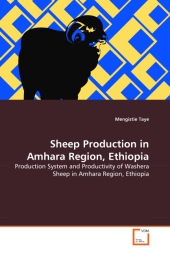 Neuerscheinungen 2011Stand: 2020-01-07 |
Schnellsuche
ISBN/Stichwort/Autor
|
Herderstraße 10
10625 Berlin
Tel.: 030 315 714 16
Fax 030 315 714 14
info@buchspektrum.de |

Mengistie Taye
SHEEP PRODUCTION IN AMHARA REGION, ETHIOPIA
Production System and Productivity of Washera Sheep in Amhara Region, Ethiopia
2011. 80 S.
Verlag/Jahr: VDM VERLAG DR. MÜLLER 2011
ISBN: 3-639-37173-9 (3639371739)
Neue ISBN: 978-3-639-37173-4 (9783639371734)
Preis und Lieferzeit: Bitte klicken
Washera sheep is indigenous sheep breed of Ethiopia. It is reared in the traditional mixed crop-livestock production systems. The main feed source for sheep is communal pasture. Farmers house their sheep throughout the year. Breeding is year round which is predominantly uncontrolled. Docking the fat tail of ewe lambs is a common practice. Washera sheep is among the better productive sheep breeds of the country. It can reach sexual maturity at about ten months and give lamb at 15.5 months of age with a weight of 24.7 kg (of ewe weight). Washera sheep can lamb nearly three times in two years with average litter size of 1.11 lambs per ewe lambing or 1.5 lambs per ewe per year. Washera sheep has a birth weight of 2.7 kg with pre-weaning average daily weight gain of 103.7 grams day-1. Washera sheep can be sold for meat at six months of age with a live body weight of 15.4 kg. Production constraints need to be improved to improve the productivity of the breed. Integrated efforts combining improved nutrition, health and participatory community-based breeding would help the smallholder farmers to utilise and conserve this immense sheep genetic resource of Ethiopia.
The author was born in Bahir-Dar town, Ethiopia. He has got Bachelor of Sciences in Animal Production & Rangeland Management and Master of Sciences in Animal Production. He has worked as a Researcher and currently he is a Lecturer at Bahir Dar University, College of Agriculture and Environmental Sciences.


